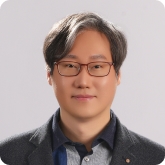- Professor
- Emeritus Professor
- Joint Professor
- Adjunct Professor
- Invited Professors
- Research Professor
Professor Yang, Chan-Ho (양찬호)
2014.12.15 16:41
-

-
Position: Professor / Head of Department of PhysicsTel&office No: +82-42-350-2513E-mail: chyang(at)kaist.ac.krHomepage: http://oxide.kaist.ac.kr/ResearchField: Experimental Condensed Matter Physics
Position
-
Professor of Department of Physics
-
Head of Department of Physics
-
Head of Graduate School of Nanoscie
Educations
-
2005 POSTECH (Ph.D. in Experimental Condensed Matter Physics)
-
2000 POSTECH (M.S. in Experimental Condensed Matter Physics)
-
1998 POSTECH (B.S. in Physics)
Experiences
-
2010~Present KAIST, Professor
-
2006~2009 UC Berkeley, Post-doc
-
2005~2006 eSSC, POSTECH, Post-doc
LAB
Thin Fim Materials Physics Laboratory
The goal of our lab is to create and explore new functionalities including multiferroic phenomena, magnetoelectric effects, and energy-related applications on the basis of transition metal oxide thin films. Our researches will be highly focused on exploring pathways to control magnetism, transport, and structural phases with an electric field using the following approaches:
Research Interest
-
Growth and Characterization of Transition Metal Oxide Thin films
Laser molecular beam epitaxy (Laser-MBE) and pulsed laser deposition (PLD) techniques for high-crystalline epitaxial film growths with atomic precision; Control of strain, synthesis of artificial structures (ordered structures, superlattices, multilayers), and stabilization of metastable phases through heteroepitaxy; Characterization of structural, electric, magnetic, and transport properties. -
Materials Processing for Devices and Nanoscale Characterization
Device fabrications using photo-lithography and dry-etching techniques; Understanding materials properties at the nanoscale using scanning probes, piezoresponse force microcopy, conducting-AFM. -
Understanding and Modulation of Strongly Correlated Phenomena in Thin Films
Inter-coupled phenomena of lattice, spin, and orbital degrees of freedom; Metal-insulator transition, colossal magnetoresistance, orbital/charge ordering, frustrated magnets, superconductivity; Structural/electric/magnetic modulation of the phenomena; Low dimensional high-mobility conduction and new magnetism in functional oxide interfaces. -
Creating New Functional Thin Films and Devices
Multiferroic thin films for magnetoelectric devices and spintronic applications; Solar energy conversion to electric power through ferroelectric heterostructures and artificial superlattices; Non-volatile information storages, ferroelectric memories, resistance-switching memories. -
The Use of Large Facilities
Resonant X-ray scattering for probing electron orbital/charge ordered systems using synchrotron source; Strong collaborations for nanoscale characterization of defect/electronic structure through state-of-the-art characterization tools of photoemission electron microscopy (PEEM) and electron microscopy to carry out element specific spectromicroscopy.







